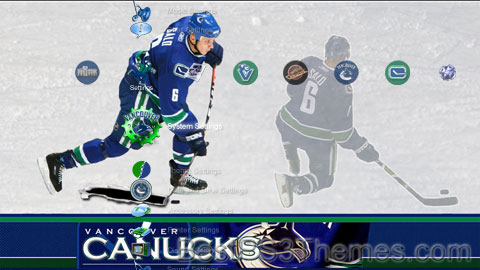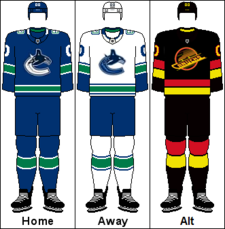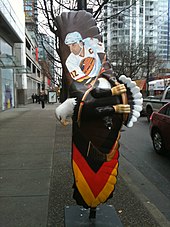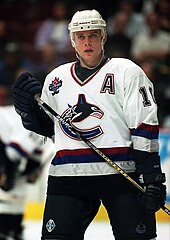Vancouver Canucks theme by Ramirez_inc
Download: VancouverCanucks.p3t

| Vancouver Canucks | |
|---|---|
 | |
| Conference | Western |
| Division | Pacific |
| Founded | 1945 (PCHL) 1970 (as NHL expansion team) |
| History | Vancouver Canucks 1945–1952 (PCHL) Vancouver Canucks 1952–1970 (WHL) Vancouver Canucks 1970–present (NHL) |
| Home arena | Rogers Arena |
| City | Vancouver, British Columbia |
 | |
| Team colours | Blue, green, white[1][2] |
| Media | Sportsnet Pacific Sportsnet One Sportsnet 650 |
| Owner(s) | Canucks Sports & Entertainment (Francesco Aquilini, chairman) |
| General manager | Patrik Allvin |
| Head coach | Rick Tocchet |
| Captain | Quinn Hughes |
| Minor league affiliates | Abbotsford Canucks (AHL) Kalamazoo Wings (ECHL) |
| Stanley Cups | 0 |
| Conference championships | 3 (1981–82, 1993–94, 2010–11) |
| Presidents' Trophy | 2 (2010–11, 2011–12) |
| Division championships | 11 (1974–75, 1991–92, 1992–93, 2003–04, 2006–07, 2008–09, 2009–10, 2010–11, 2011–12, 2012–13, 2023–24) |
| Official website | www |
The Vancouver Canucks are a professional ice hockey team based in Vancouver. The Canucks compete in the National Hockey League (NHL) as a member of the Pacific Division of the Western Conference, and play their home games at Rogers Arena. Rick Tocchet is the head coach, Jim Rutherford serves as the president of hockey operations, and Patrik Allvin serves as the general manager.[3][4]
The Canucks joined the league in 1970 as an expansion team along with the Buffalo Sabres. The team has advanced to the Stanley Cup Finals three times, losing to the New York Islanders in 1982, the New York Rangers in 1994 and the Boston Bruins in 2011. They have won the Presidents' Trophy in back-to-back seasons as the team with the league's best regular season record in both the 2010–11 and 2011–12 seasons. The Canucks have won three division titles as a member of the Smythe Division from 1974 to 1993, seven titles as a member of the Northwest Division from 1998 to 2013, and one title as a member of the Pacific Division in 2024. The Canucks, along with the Sabres, are the two oldest teams in the NHL to have never won the Stanley Cup.[5]
The Canucks have retired six players' jerseys in their history—Pavel Bure (10), Stan Smyl (12), Trevor Linden (16), Markus Naslund (19), Daniel Sedin (22) and Henrik Sedin (33); all but Bure and Daniel Sedin have served as team captain, and all but Naslund were on one of the three Stanley Cup Finals rosters. Smyl has the distinction of being the only Canuck to have his jersey number retired at their former arena, Pacific Coliseum.
History[edit]
Background and establishment[edit]
The first professional ice hockey team based in Vancouver were the Vancouver Millionaires, formed by Frank and Lester Patrick. Established in 1911, the Millionaires were one of three teams in the new Pacific Coast Hockey Association. To accommodate the Millionaires, the Patrick brothers directed the building of the Denman Arena, which was known at the time as the world's largest artificial ice rink.[6] The arena was later destroyed in a fire in 1936. The Millionaires played for the Stanley Cup five times, winning over the Ottawa Senators in 1915 on home ice.[7] It marked the first time the Stanley Cup was won by a West Coast team in the trophy's history.[7] Absorbed by the Western Canada Hockey League in 1924, the team continued operations until folding at the end of the 1925–26 WHL season.
From 1926 to 1970, Vancouver was home to only minor league teams. Most notably the present-day Canucks' minor league predecessor (also known as the Vancouver Canucks) played from 1945 to 1970 in the Pacific Coast Hockey League and the Western Hockey League.
NHL application[edit]
With the intention of attracting an NHL franchise, Vancouver began the construction of a new modern arena, the Pacific Coliseum, in 1966 (with the arena opening in January 1968).[8] The WHL's Canucks were playing in a small arena at the time, the Vancouver Forum, situated on the same Pacific National Exhibition grounds as the Coliseum. Meanwhile, a Vancouver group led by WHL Canucks owner and former Vancouver mayor Fred Hume made a bid to be one of the six teams due to join the league in 1967, but the NHL rejected their application.[9] Bid leader Cyrus McLean called the denial a "cooked-up deal", referring to several biases that factored against them. Speculation long abounded afterwards that the bid was hindered by Toronto Maple Leafs president Stafford Smythe; after a failed Vancouver-based business deal, he was quoted as saying that the city would not get an NHL franchise in his lifetime.[10] Additionally, along with the Montreal Canadiens, Smythe purportedly did not wish to split Canadian Broadcasting Corporation (CBC) hockey revenues three ways rather than two.[11]
Less than a year later, the Oakland Seals were in financial difficulty and having trouble drawing fans. An apparent deal was in place to move the team to Vancouver, but the NHL did not want to see one of their franchises from the expansion of 1967 move so quickly and vetoed the deal. In exchange for avoiding a lawsuit, the NHL promised Vancouver would get a team in the next expansion round.[12] Another group, headed by Minnesota entrepreneur Tom Scallen, made a new presentation and was awarded an expansion franchise for the price of $6 million (three times the cost in 1967).[13] The new ownership group purchased the WHL Canucks, and brought the team into the league with the Buffalo Sabres as expansion teams for the 1970–71 season.
In preparation for joining the NHL, the WHL Canucks had brought in players with prior NHL experience. Six of these players (John Arbour, George Gardner, Len Lunde, Marc Reaume, Ted Taylor and Murray Hall) would remain with the club for its inaugural NHL season. The rest of the roster was built through an expansion draft.
Early years (1970–1982)[edit]
To fill the Canucks' roster for their inaugural season, the league held an Expansion Draft in the preceding summer. A draft lottery was held on June 9, 1970, determining who between the Canucks and Sabres would get the first selection in the Expansion Draft, as well as the 1970 NHL Amateur Draft; the Sabres won both spins. With his first selection in the Expansion Draft, Canucks General Manager Bud Poile chose defenceman Gary Doak.[14] Among the other players chosen by Vancouver were centre Orland Kurtenbach, who was named the Canucks' first captain,[15] as well as defenceman Pat Quinn, who later became the team's general manager and coach in the 1990s. Two days later, on June 11, 1970, the Canucks made defenceman Dale Tallon their first-ever Amateur Draft selection. Tallon played three seasons with the club before being traded away to the Chicago Black Hawks. By comparison, the Sabres chose centre Gilbert Perreault with the first overall selection they won from the lottery; Perreault went on to become a nine-time All-Star and member of the Hockey Hall of Fame.[16]

With the Canucks' roster set, the team played its inaugural game against the Los Angeles Kings on October 9, 1970. They lost the contest 3–1; defenceman Barry Wilkins scored the Canucks' lone goal in the game and first in franchise history, a backhander against goaltender Denis DeJordy.[17] Two days later, the squad recorded the first win in franchise history, a 5–3 victory over the Toronto Maple Leafs.[18]
The Canucks struggled in their early years, failing to make the playoffs in their first four seasons.[19] Placed in the competitive East Division, Poile assembled a core of players during this period led by Kurtenbach that included defencemen Tallon and Jocelyn Guevremont, as well as wingers Andre Boudrias and Dennis Ververgaert. Boudrias emerged as the team's leading point-scorer in four of their first five seasons.[20]
Prior to the 1974–75 season, Scallen and his ownership group from Minnesota sold the team to local media mogul Frank Griffiths for $9 million.[21] Also in the summer of 1974, the Canucks were re-aligned within the league and placed in the new Smythe Division. They responded with their first winning record (38 wins, 32 losses and 10 ties), backstopped by goaltender Gary "Suitcase" Smith finishing first in the Division with 86 points.[20] Making their debut in the Stanley Cup playoffs, the Canucks lost the opening series of the 1975 playoffs in five games to the Montreal Canadiens. Head coach and general manager Phil Maloney (the third GM in team history after Poile and Hal Laycoe) recalled the importance of a successful season for the Canucks in that year specifically, as the rival league World Hockey Association (WHA) had established another major professional team in the city, the Vancouver Blazers. Competing for the same hockey market, the Canucks emerged over the Blazers as the latter relocated to Calgary, Alberta, the following season.[22] The Canucks posted a second consecutive winning record and made the playoffs in 1975–76, but lost to the New York Islanders in a two-game preliminary series.[19] It would be another 16 years until the team would have another winning record though they made the playoffs nine times in that span.[20]
Kurtenbach retired and assumed a coaching position with Vancouver. His departure as a player marked the beginning of a seven-year period in which the Canucks had four different captains—Boudrias, Chris Oddleifson, Don Lever and Kevin McCarthy. Following the 1976–77 season, Maloney was replaced as general manager by Jake Milford, who acquired such players as Stan Smyl, Thomas Gradin, Darcy Rota, Ivan Boldirev and Richard Brodeur, a core that would lead the team throughout the 1980s.[23]
1982 Stanley Cup run[edit]

The Canucks made their first significant playoff impact in the 1982 playoffs. In their previous five playoff appearances, the team had failed to win a single series. Though the Canucks finished three games under a .500 win percentage in the 1981–82 regular season, they began gaining momentum by finishing the campaign on a nine-game unbeaten streak.[24] Meanwhile, Smyl emerged as the club's leader, replacing McCarthy as the captain after the latter was sidelined with an injury late in the season (he would retain that position for a team-record eight years).[25][26] Continuing their success in the playoffs, the Canucks made the Stanley Cup Finals with a combined 11–2 record in series against the Calgary Flames, Los Angeles Kings, and Chicago Black Hawks.[19] Despite having a losing regular season record, Vancouver had a home-ice advantage in the first series, having finished second in the Smythe Division to the Edmonton Oilers. The Canucks also had a home-ice advantage during the second-round series against the Kings, who upset the Oilers in the first round.
Late in Game 2 of the Conference Finals in Chicago, Vancouver Interim Head Coach Roger Neilson, frustrated with what he felt was the poor officiating in the game, placed a white towel on the end of a hockey stick and held it up in a gesture mocking surrender (waving the white flag). The players on the Canucks' bench followed suit. When the series shifted to Vancouver for the next two games, the team's fans cheered them on by waving white towels above their heads. The habit stuck, becoming an original Canuck fan tradition now seen across the league and in other sports, known as "Towel Power." The Canucks proceeded to win the series in five games, making it to the Stanley Cup Finals for the first time in their history.[27]
Entering the Finals against the New York Islanders, the Canucks were the first team from Western Canada to play for the Stanley Cup in 56 years, when the Victoria Cougars reached the 1926 Stanley Cup Finals. It also marked the first-ever coast-to-coast Stanley Cup Finals.[28] Competing against the Islanders—the Stanley Cup champions of the previous two years, who had finished with 41 points more than Vancouver in the regular season standings—Vancouver took the first game to overtime. In the final minute of the extra period, Canucks defenceman and fan favourite Harold Snepsts gave the puck away with an errant pass from behind his net, leading to a Mike Bossy goal. Like the first game, the Canucks held a 3–2 lead after the first two periods in the second game, but were not able to keep their lead, and lost 6–4.[29] The Canucks were unable to complete their Cinderella run and were swept, losing their next two games by 3–0 and 3–1 scores. The 1982 playoffs proved to be the last year in which Vancouver won a playoff series until 1992.[19]
Decline (1982–1987)[edit]
After their improbable Stanley Cup run, the Canucks slipped back into mediocrity for the rest of the 1980s, making the playoffs only four times for the rest of the decade.[19] Notable players that joined the Canucks' core following the 1982 playoffs included offensively skilled forwards Patrik Sundstrom and Tony Tanti. Beginning in 1983–84, the Canucks' scoring title was held by either Sundstrom or Tanti for four of the next five seasons, the only season in which neither won the team scoring title was 1985–86, when it was won by Petri Skriko. For most of the second half of the 1980s, the Canucks competed with the Los Angeles Kings for the final playoff spot in the Smythe Division. In the years in which they qualified for the playoffs, the team was eliminated in the first round by either the Edmonton Oilers (in 1985–86) or the Calgary Flames (in 1982–83, 1983–84 and the Flames championship season of 1988–89, which was decided in Game 7), both division rivals.[19]

Following Milford's tenure as general manager from 1977 to 1982, the position was held by Harry Neale for three years, then Jack Gordon for two. The latter was responsible for trading away power forward Cam Neely to the Boston Bruins in 1986.[30] In addition to Neely, the Canucks gave up their 1987 first-round draft pick, with which the Bruins chose Glen Wesley, and in return acquired centre Barry Pederson. While Pederson collected back-to-back 70-point seasons with the Canucks in his first two seasons after the trade, he was traded away to the Pittsburgh Penguins in 1989 as his performance quickly declined.[31] Neely went on to have a Hall of Fame career with the Bruins, recording three 50-goal seasons,[32] and Wesley had a solid 20-year career.[33]
Pat Quinn era (1987–1998)[edit]
After the installation of former Canucks defenceman Pat Quinn as general manager in the summer of 1987,[34] the team underwent an immediate rebuilding process, trading away core veterans for younger prospects and players. Among the more key transactions was a deal with the New Jersey Devils, in which Sundstrom was traded away in exchange for winger Greg Adams and goaltender Kirk McLean. In addition to Quinn's trades, the team improved through the draft route with two selections, in particular. With the second overall selection in the 1988 NHL Entry Draft, the Canucks chose winger Trevor Linden from the Western Hockey League (WHL). The following year, the team made a controversial selection by choosing Russian winger Pavel Bure 113th overall. Bure was believed by most teams to be ineligible for selection that year. Consequently, his draft by the Canucks took a year to be verified by the league as team management went about procuring documents to prove his eligibility.[35]
As the decade turned, a shift in the Canucks' leadership occurred as Stan Smyl resigned his captaincy prior to the 1990–91 season due to a reduced on-ice role with the team. In his place, the Canucks implemented a rotating captaincy of Linden, Dan Quinn and Doug Lidster; of the three, Linden retained the captaincy thereafter, becoming the youngest permanent captain in team history at 21 years of age. At the end of the season, Smyl retired as the team's all-time leader in games played, goals, assists and points.[36] Led by Linden and in large part to Quinn's dealings, the Canucks rose to prominence in the early 1990s. This increased success came roughly around the time the Oilers and Flames began to sink in the standings. As a result, Vancouver won their first division title in 17 years with 42 wins, 26 losses and 12 ties during the 1991–92 season (it was also the team's first winning season since the 1975–76 season). During the campaign, the Canucks honoured Smyl, who had remained on the team as an assistant coach, by making him the first player in team history to have his jersey (number 12) retired.[36] In the 1992 playoffs, the Canucks won their first series since 1982 before being eliminated by the Oilers in the second round.[19] Quinn and Bure became the first Canucks recipients of major NHL awards in the off-season, being awarded the Jack Adams Award as the best coach (Quinn assumed a dual coaching and general managerial role starting that year) and the top rookie in the league, respectively.[37] The following year, the Canucks repeated as regular season division champions, while Bure emerged as arguably the team's first superstar with his first of back-to-back 60-goal seasons, totals which remain the highest recorded in Canucks history.[38] As the team struggled to score in the second half of the 1993–94 season, Bure recorded 49 goals in the club's final 51 games and contributed to 46.45% of his team's goals in the final 47 games of the season to carry the Canucks into the 1994 postseason. Jim Matheson of the Edmonton Journal called Bure "the NHL's best forward the last 40 games, scoring almost a goal a game."[39]
1994 Stanley Cup run[edit]

In 1994, the Canucks made their second trip to the Stanley Cup Finals, entering the playoffs as the seventh seed in the renamed Western Conference. Despite underachieving in the regular season (their points total decreased by 16 from the previous year, although they finished second in the newly renamed Pacific Division),[20] the Canucks played well in the playoffs and embarked on another unexpected run.
Opening the playoffs with a close first-round series against the Calgary Flames, Vancouver rallied from a three-games-to-one deficit to win the series in seven contests. Games 5 through 7 were all won in overtime with goals from Geoff Courtnall, Trevor Linden, and Pavel Bure, respectively.[40] The deciding seventh game featured two of the most recognizable and celebrated plays in Canucks history. With the game tied 3–3 in the first overtime, goaltender Kirk McLean made what became known thereafter as "The Save", sliding across the crease feet-first and stacking his pads on the goal line to stop Robert Reichel on a one-timer pass from Theoren Fleury. The following period, Pavel Bure received a breakaway pass from defenceman Jeff Brown before deking Calgary goaltender Mike Vernon to score and win the series. Fifteen years later, Bure's goal and McLean's save were ranked first and second in a Vancouver Sun article listing the "40 most memorable moments in team history."[41]
Following their victory over the Flames, the Canucks then upset both the Dallas Stars and Toronto Maple Leafs (both in five games) en route to the franchise's second Stanley Cup Finals appearance.[19] Forward Greg Adams sent the Canucks into the Finals with a double-overtime goal against Maple Leafs goaltender Felix Potvin in Game 5.[41] Staging the second coast-to-coast Finals in league history, the Canucks were matched against the Presidents' Trophy-winning New York Rangers. Vancouver achieved victory in Game 1 by a score of 3–2 in overtime, largely due to a 52-save performance by goaltender McLean.[42] After losing the next 3 games, the Canucks won the next two to force a seventh game at Madison Square Garden on June 14, 1994.[19] Despite a two-goal effort (one on a shorthanded breakaway) from Linden (who was playing with cracked ribs),[43] Vancouver lost the game by a 3–2 score. The Canucks' efforts to tie the game included a post hit by forward Nathan LaFayette with just over a minute remaining in regulation.[44] The loss was followed by a riot in Downtown Vancouver, which resulted in property damage, injuries and arrests.[45] Two days after the riots, the team held a rally at BC Place attended by 45,000 fans, who congratulated the team for their effort.[46]
With a young core that included Linden, Bure and McLean still in their 20s after the 1994 playoffs, the Canucks appeared poised to remain contenders in the league.[44] However, the team failed to record a winning season in the six years following their Stanley Cup Finals appearance.&
8 Replies to “Vancouver Canucks”
Comments are closed.

Vancouver Canucks theme.
10 Different wallpapers.
BOOOO!!!!!!!!
Blues are 15X worse, 0-4 in the playoffs is worse than pathetic
YESSSSSSSSSSA!!!!!!!!!!!!!!!!!
I got this installed but I did not get any background wallpapers to show up
PITTSBURGH PENGUINS KICK FREAKIN ASS!
look who just won the stanley cup….oh yeah! thats right. we did!!
BOOOO!!!cunucks are so gay and way down there and were like what? 3rd in the leage? yeah thats right. FLYERS SUCK! CUNUCKS ARE YUCK! haha i DIDNT make that up:) january 24….pens vs.flyers…… LETS GO PENS!
CROSBYS WASHED UP…O I JUST GOT MY FIRST GOAL IN THE OLYPICS IM HOT SHIT.,fuck you u piece of shit loooooooouuuuuuu
I could make a better Canucks theme…in fact….I will! 😀